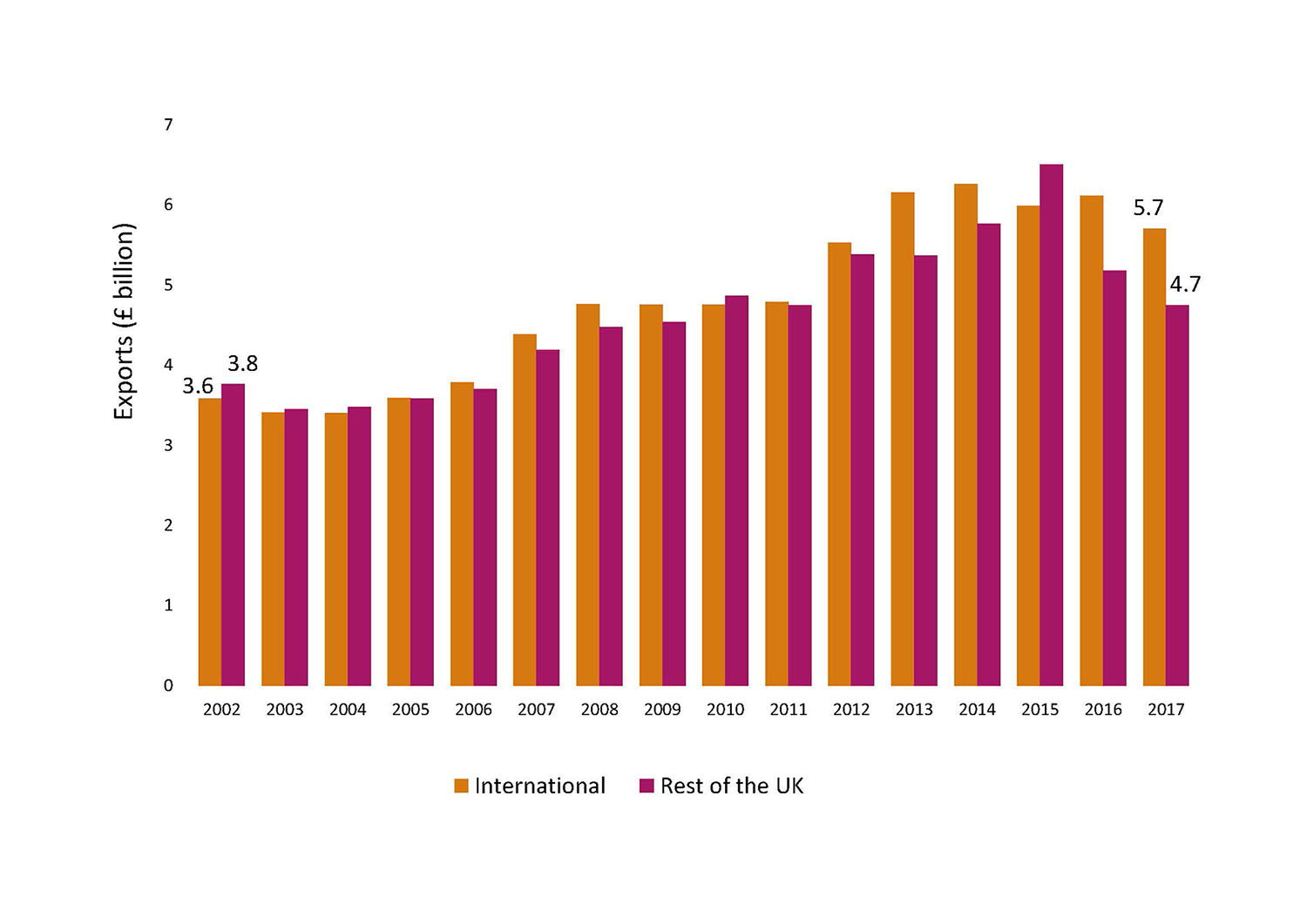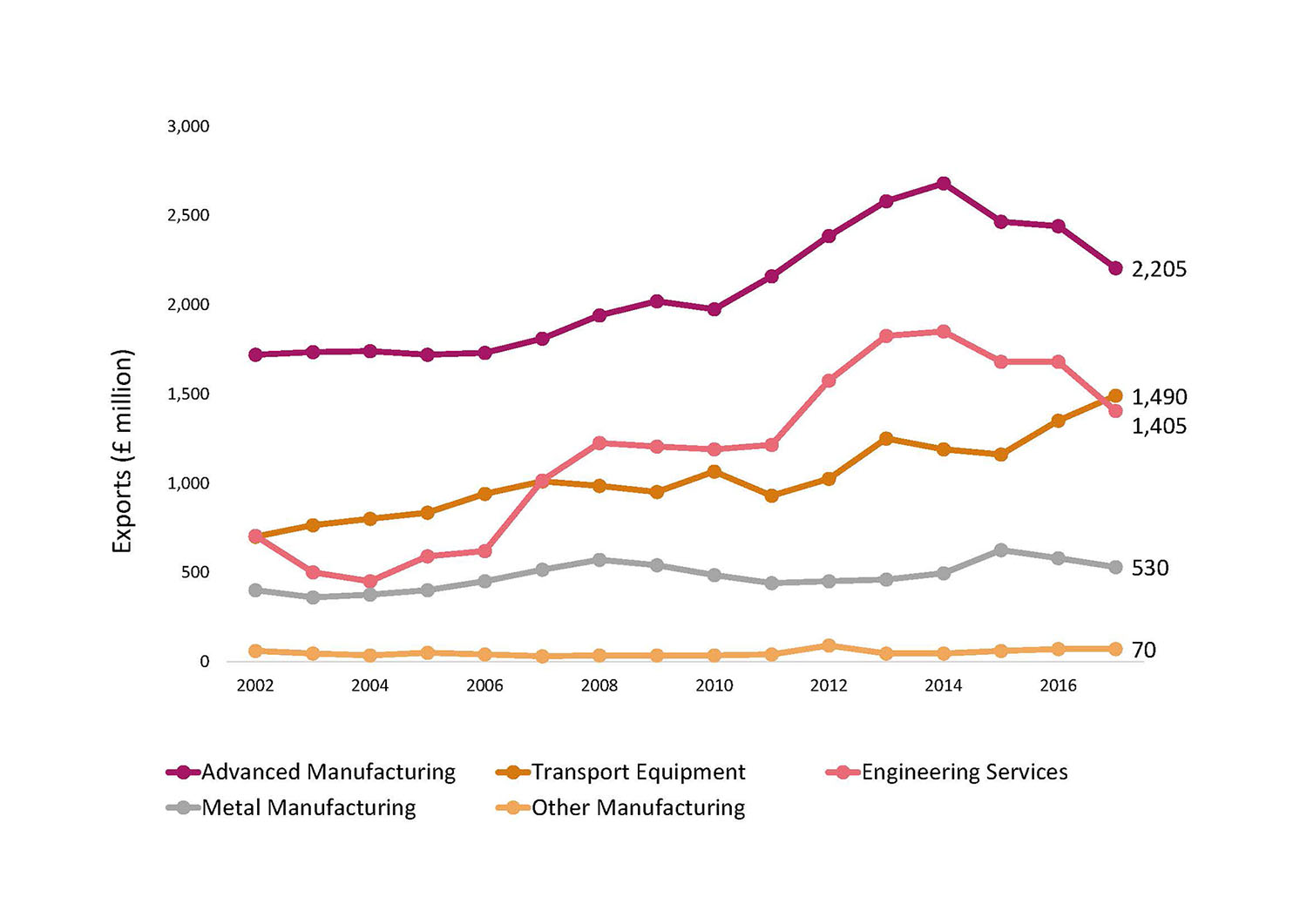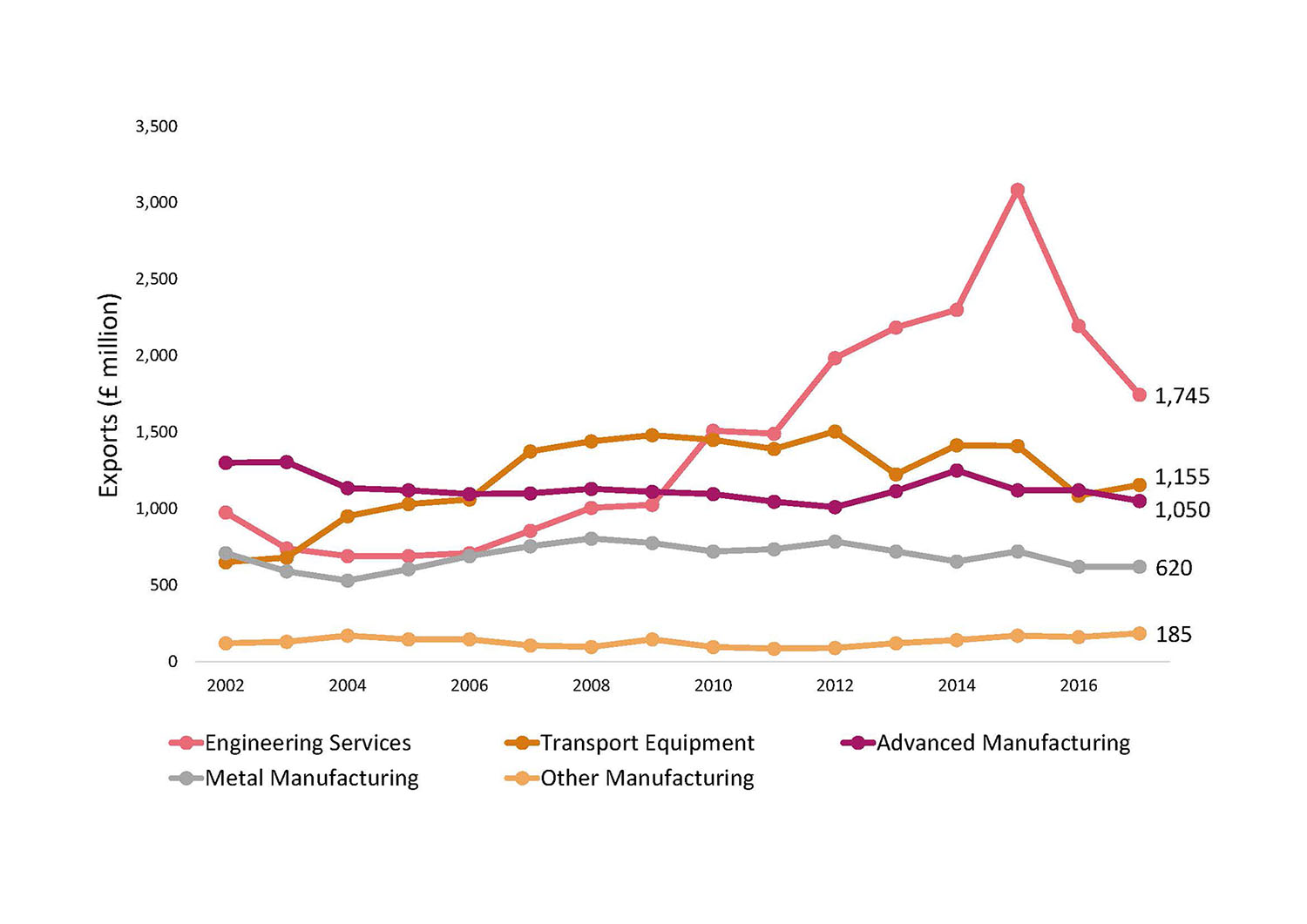Engineering and Advanced Manufacturing
Introduction
The engineering and advanced manufacturing sector is one of Scotland’s largest export sectors. It includes both the manufacturing and engineering services side of engineering. The largest subsectors are advanced manufacturing, transport wquipment and engineering services.
In 2017, the engineering and advanced manufacturing sector accounted for 9.6 per cent of total enterprises in Scotland, 7.3 per cent of total employment and 9.9 per cent of total turnover (see Table 1 for more detail).
Table 1:
Engineering and Advanced Manufacturing, Number of Enterprises, Employment and Turnover, 2017
| All Private Sector VAT/PAYE Registered Enterprises |
||||||
| Sector/Sub-sector |
Enterprises |
Employment |
Turnover (£ million) |
Enterprises (% of total) |
Employment (% of total) |
Turnover (% of total) |
| Engineering and Advanced Manufacturing |
16,935 |
141,940 |
25,784 |
100% |
100% |
100% |
| Metal Manufacturing |
2,095 |
24,770 |
3,115 |
12% |
17% |
12% |
| Advanced Manufacturing |
1,140 |
29,800 |
4,979 |
7% |
21% |
19% |
| Transport Equipment |
305 |
14,730 |
3,510 |
2% |
10% |
14% |
| Engineering Services |
12,590 |
67,360 |
13,669 |
74% |
47% |
53% |
| Other Manufacturing |
800 |
5,300 |
512 |
5% |
4% |
2% |
Source: Inter-departmental Business Register (IDBR). Proportions may not sum to 100 due to rounding.
Export Performance
In 2017, the engineering and advanced manufacturing sector accounted for around 17.6 per cent (£5.7bn) of Scotland’s total international exports and 9.7 per cent (£4.7 bn) of Scotland’s total exports to the rest of the UK. International exports and exports to the rest of the UK have grown relatively consistently over time in this sector, although there has been a reduction in exports in recent years (Figure 1).
Figure 1:
Engineering and Advanced Manufacturing Exports, International and Rest of UK, 2002-2017

Source: Scotland’s Export Performance Monitor
Export Performance by Sub-sector – International
In 2017, the majority of international exports in the engineering and advanced manufacturing sector was accounted for by three sub-sectors: engineering services, transport equipment and advanced manufacturing. Almost all sub-sectors have grown since 2002, with engineering services, advanced manufacturing and transport equipment showing the strongest growth over the period (Figure 2). That said, exports from some sub-sectors (notably engineering services and advanced manufacturing), have weakened in recent years.
Figure 2:
Engineering and Advanced Manufacturing International Exports by Sub-sector, 2002-2017
 Source: Scotland’s Export Performance Monitor
Source: Scotland’s Export Performance Monitor
Export Performance by Sub-sector – Rest of the UK
Similar to international exports, the majority of exports to the rest of the UK in the engineering and advanced manufacturing sector was accounted for by engineering services, transport equipment and advanced manufacturing. Engineering services exports have grown significantly over time, despite declining in recent years (Figure 3). This growth has partly been driven by the provision of services to the oil and gas sector, including the North Sea UK Continental Shelf (which is counted as an export to “Rest of the UK” in the data).
Figure 3:
Engineering and Advanced Manufacturing, Exports to Rest of UK by Sub-sector, 2002-2017

Our Strengths
- Scotland already has an international reputation for excellence in these fields with many senior positions in international companies held by Scottish engineers.
- Having a resource like the Scottish Manufacturing Advisory Service (SMAS) to support businesses develop.
- Research and development has great potential with the right partnerships with universities.
- Graduate apprentices are a valuable resource – 80%/20% split between employment and academia. Work-based learning is more effective and facilitates accreditation.
- Direct competitors are willing to work together and collaborate which facilitates the peer-to-peer mentoring approach.
Our Challenges
- Ensuring the right support is available for peer-to-peer mentoring to upskill the leadership teams of SMEs, helping them move towards internationalisation.
- An industry-wide staff shortage stretching beyond the UK to the rest of Europe. Globally the sector is short on civil, mechanical and electrical engineers
− Lack of skilled engineers in a sector where technology is developing rapidly.
− 2017 Engineering UK forecast the need for 265,000 skilled workers annually until 2024
(including 79,000 emerging engineering-related roles per year).
- Brexit uncertainty for the sector for a number of reasons:
− recruitment – the sector currently employs a lot of overseas workers whose rights to work in the UK may be affected.
− retaining international talent to enter the workforce as the UK is now a less attractive option.
− continuing international collaboration due to differing restrictions under EU and upcoming UK laws.
− negative impacts on supply chains – increased complication of safety regulations, checks on imports in and out of the EU.
Our Opportunities
- Commitment to delivering the Advanced Manufacturing Innovation District Scotland (AMIDS) which will be an internationally recognised centre for innovation, research and manufacturing allowing the sector in Scotland to be at the forefront of world leading approaches in the sector.
- Strong network of GlobalScots in this sector who can support identification of opportunities and provide soft landing for businesses.
Current Export Markets
In 2017, the top five international export destinations for the engineering and advanced manufacturing sector as a whole were:
- USA
- Germany
- France
- Netherlands
- Norway
The top five export markets vary between sub-sectors, a more detailed breakdown is provided below (Table 2).
Table 2:
Top Five Destinations for Engineering and Advanced Manufacturing Exports by Sub-sector, 2017(1)
| Sub Sector |
Country |
| Advanced Manufacturing |
Germany, France, USA, Italy, Netherlands |
| Transport Equipment |
USA, Poland, Netherlands, Brazil, Canada |
| Engineering Services |
USA, Switzerland, Ireland, Norway, Germany |
Source: Scotland’s Export Performance Monitor
Key Growth Markets
Analysis for A Trading Nation, identifies 15 priority markets in which there are significant opportunities to increase Scotland’s exports as well as a further 11 where there are more specific sectoral opportunities. Table 3 below breaks down these opportunity markets for engineering and advanced manufacturing exports.
Table 3:
Potential Opportunity Markets for Scotland’s Engineering and Advanced Manufacturing Exports
Engineering and Advanced Manufacturing:
| Category |
Countries |
| Large and growing demand for imports in this sector |
United States, Germany, China, Italy, Canada, Spain, Mexico |
| Scotland currently underperforming similar competitors in this sector |
Germany, Netherlands, Poland, China, Ireland, South Korea |
Actions We Will Take
- Industry, SDI and Scottish Government will work together on market development plans in selected sub-sectors and markets.
- Supporting the development of international leadership and sales skills in businesses.
- Working through industry bodies to share innovation and exporting best practice to engineering SME’s.
- Addressing access to high quality graduate and technical talent supply.
- Ensuring continued avilability of skilled overseas employees (post-Brexit).
- Championing access to business finance linked to export growth plans.
- Identifying GlobalScots/Trade Envoys who are in a position to provide advice/support/ introductions to benefit businesses in this sector.
- Exploring ways of making our data analysis models on the sector available to help to identify the exporting gaps.
Stakeholder Consultation
In total, more than 30 organisations have been consulted in the development of this plan. These consultations have helped to shape the plan and have helped us to make links to other relevant work within individual sectors.
While we are not able to reflect all the comments and input we received through these consultations, some pertinent points from key consultees in this sector are captured below.
Key consultees in this sector included Scottish Engineering and Association for Consultancy and Engineering.
There is a general acknowledgment of the challenges linked to handling and analysing export data held as it identifies the point of shipment, rather than of the destination country.
The export value gap used as an analysis tool for identifying opportunities as part of this plan is positive and ties in to the industry identifying areas with strong export potential and helps them focus on their development.
There is a need to support businesses improve their leadership capacity, particularly SMEs, in order to move towards internationalisation. Peer-to-peer mentoring is the most effective way of helping to upskill and in general, in this industry, direct competitors are willing to work together and collaborate.
There is a need to spread awareness of available support and it is important to have continuing and consistent programmes that help exporters and ‘potential exporters’ engage. A structured approach for each market with programmes focused on what is of most interest to businesses is what is required for this sector.
References:
(1) For some sub-sectors, the values at a destination country level are less robust. Where this is the case they have not been included in this table